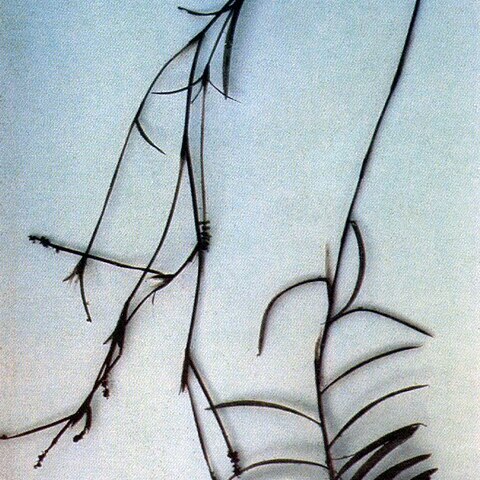Rhizomes present. Cauline stems terete, without spots, to 100 cm; glands absent. Turions absent. Leaves submersed, conspicuously 2-ranked, sessile, stiffish; stipules persistent, conspicuous, adnate to base of blade about ± ¼ length of stipule, connate, greenish brown to white, ligulate, 0.5--2 cm, fibrous, shredding at tip, apex obtuse; blade dark green to reddish green, linear to lanceolate, not arcuate, 2--7(--12) cm ´ 3--4(--8) mm, base rounded, with basal lobes, not clasping, margins minutely spinulose to serrulate, not crispate, apex not hoodlike, acute, lacunae absent; veins 20--60, fine. Inflorescences often branched; peduncles not dimorphic, axillary, erect, cylindric, 3--5(--7) cm; spikes not dimorphic, moniliform (i.e., beaded), 7--20 mm. Fruits stipitate, brown, obliquely obovoid, turgid, abaxially and laterally keeled, 3--4(--5) ´ 2(--3.3) mm, lateral keels without points; beak erect, recurved at apex, 0.7--0.9 mm; sides without basal tubercles; embryo with less than 1 full spiral. 2n = 52.
More
Stems to 1 m, sparingly branched below, repeatedly branched above when flowering; rhizome not tuberous; lvs all submersed, crowded on sterile stems (the internodes often only 1 cm), rather firm, distichous, linear, 3–10 cm × 3–8 mm, abruptly contracted and with rounded auricles at the juncture with the stipule, with prominent midvein and numerous (20–60) fine lateral veins, the margin pale and somewhat cartilaginous, usually minutely spinulose-serrulate at least toward the acute tip; stipular sheath open, adnate to the blade for 5–15 mm, the free part as long or longer, soon disintegrating into coarse fibers; peduncles numerous, almost paniculate, 2–5 cm, subtended by stipular sheaths with the blades much reduced or none and often accompanied by winter-buds; spikes slender, 7–15 mm, with 3–5 separated whorls of fls; achenes rarely produced, obovoid, 3.5–4.5 mm, with a narrow, sharp dorsal keel and 2 rounded lateral ones; 2n=52. Quiet water; Que. to B.C., s. to Del., Ala., Minn., and Oreg.


